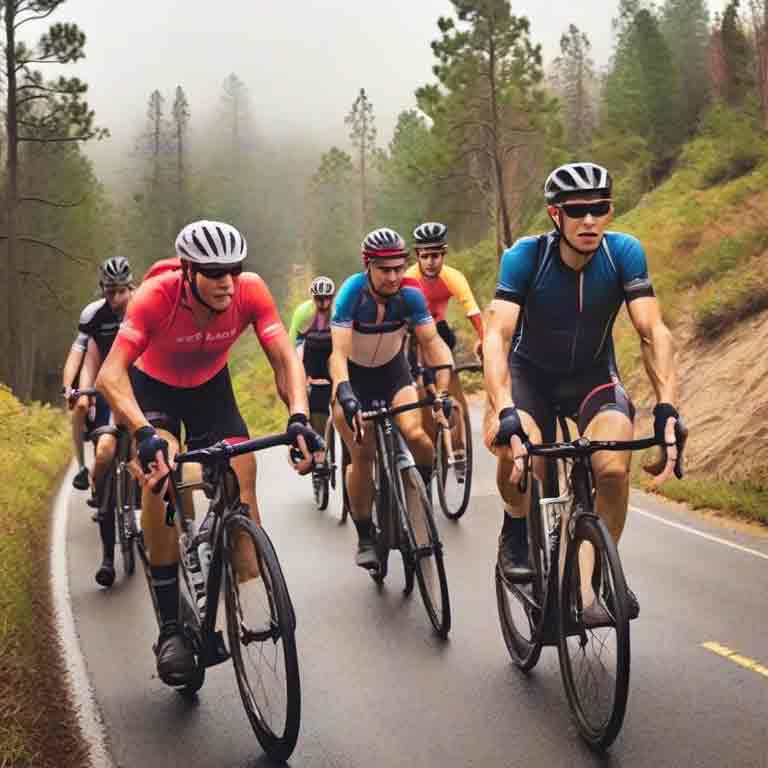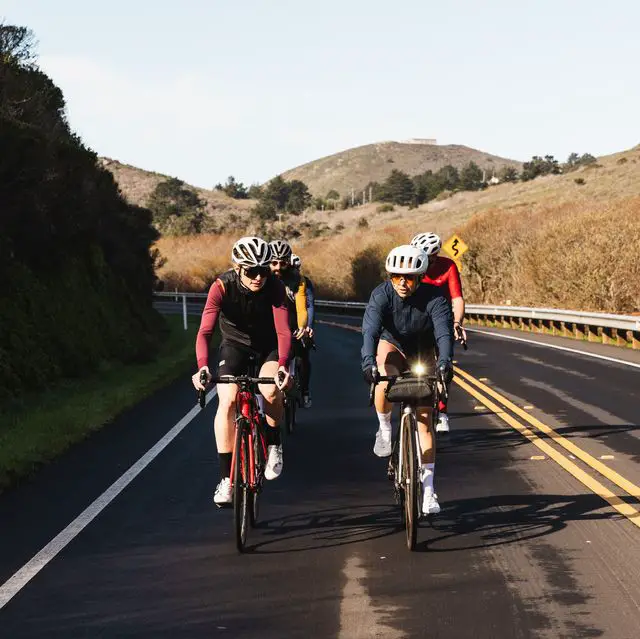Tricky group ride situations! Navigating tricky group ride situations requires clear communication and quick decision-making. Here are seven challenging scenarios and how to handle them.
Group rides can be exhilarating but come with unique challenges. Cyclists must stay alert and communicate effectively to ensure safety and enjoyment for everyone. From dealing with mechanical issues to managing different skill levels, these rides test both your biking skills and your ability to work as a team.
Addressing these tricky situations head-on can prevent accidents and improve the overall experience. Understanding how to handle these challenges will make your group rides smoother and more enjoyable. This guide offers practical tips to tackle seven common tricky group ride situations effectively.

Credit: www.invaluable.com
Introduction To Group Cycling Dynamics
Riding in a pack makes cycling easier. Cyclists share the effort. Wind resistance is lower. Friends bond during rides. Group rides are safer. More eyes watch the road. Riders push each other. Performance improves over time.
Group rides have challenges. Keeping pace is hard. Riders have different speeds. Communication can be tough. Hand signals help a lot. Weather changes add difficulty. Rain makes roads slippery. Hills can tire riders quickly. Staying hydrated is crucial.
Participating in a group ride can be an enjoyable and rewarding experience for cyclists. However, it comes with its own set of challenges and tricky situations. Here are seven tricky group ride situations and how to handle them:
- Overlapping Wheels
- Situation: This occurs when a rider’s front wheel overlaps the rear wheel of the cyclist ahead.
- Solution: Maintain a safe distance and avoid overlapping wheels. If the rider ahead swerves, it can cause a crash. Communicate intentions clearly and keep a steady line.
- Sudden Stops
- Situation: A cyclist in the group suddenly brakes or stops without warning.
- Solution: Always stay alert and anticipate possible stops. Leave enough space between you and the rider in front. Use hand signals to indicate slowing down or stopping.
- Changing Pace
- Situation: The pace of the ride changes unpredictably, either speeding up or slowing down suddenly.
- Solution: Keep the group informed about any changes in pace. If you’re leading, maintain a consistent speed. If you need to accelerate or decelerate, do it gradually.
- Mechanical Issues
- Situation: A rider experiences a mechanical problem such as a flat tire or chain drop.
- Solution: Signal to the group and move to the side of the road to address the issue. The group should stop in a safe place to assist if necessary. Carry basic tools and spare parts.
- Traffic Interactions
- Situation: Navigating through traffic or busy intersections can be challenging.
- Solution: Follow traffic laws and signals. Use hand signals to indicate turns or stops. Ride single file in heavy traffic and be predictable. Communicate clearly with the group about approaching traffic.
- Riding with New or Inexperienced Cyclists
- Situation: New or less experienced riders may not be familiar with group ride etiquette.
- Solution: Offer guidance and be patient. Communicate the rules and expectations before the ride starts. Position less experienced riders in the middle of the pack where they can follow more experienced cyclists.
- Adverse Weather Conditions
- Situation: Sudden changes in weather, such as rain, wind, or extreme heat.
- Solution: Check the weather forecast before the ride and be prepared with appropriate gear. In case of adverse weather, decide as a group whether to continue, modify the route, or stop. Ensure everyone is dressed appropriately and stays hydrated.
Handling these situations effectively requires good communication, awareness, and preparation. By being considerate and following group ride protocols, you can ensure a safer and more enjoyable experience for everyone involved.
Pace Line Etiquette
Keep your speed steady and smooth. Avoid sudden changes in pace. Signal before moving to the front. Do not stay too long at the front. Rotate off smoothly after your turn. Rejoin the line at the back.
Always signal turns and stops. Use hand signals to point out hazards. Call out obstacles like potholes or gravel. Communicate with the group using simple words. Make sure everyone hears your signals. Stay alert and watch for signals from others.
Dealing With Varied Skill Levels
Slower riders need support. Plan regular breaks for the group. Keep the pace easy for them. Offer encouragement and tips. This boosts their confidence. It also builds team spirit.
Faster cyclists crave challenges. Suggest sprints during the ride. Create short, intense segments. This keeps them engaged. They also improve their skills. Rotate leaders to keep it fair. Everyone gets a chance to lead. This balances the ride.

Credit: www.bicycling.com
Navigating Intersections As A Group
Traffic lights can split a group. Riders should stay close. This helps keep everyone together. Use hand signals to communicate. Follow the leader’s pace carefully. Do not rush through yellow lights. Safety is more important than speed.
Cornering can be tricky in groups. Maintain your line through the turn. Avoid sudden movements. Follow the rider in front of you. Keep a safe distance. Lean together for better balance. Communicate with hand signals.
Unexpected Obstacles On The Road
Group rides often encounter unexpected obstacles on the road, creating tricky situations. Riders must stay alert to avoid potential hazards.
Quick Maneuvering
Riders often face sudden obstacles. Quick thinking is key. Maintain a safe distance. Always stay alert. Avoid abrupt movements. Communicate clearly with hand signals. Practice emergency stops regularly. Smooth maneuvers ensure safety.
Alerting Following Riders
Use hand signals to warn others. Point to obstacles ahead. Shout warnings if needed. Make sure everyone hears. Pass the message down the line. Keep the group informed. Safety depends on clear communication.
Mechanical Failures Mid-ride
Stopping as a group is a must. Safety comes first. Riders should signal and slow down. Everyone should move to a safe spot. Check for traffic and hazards. Communication is key. A quick check on everyone’s status helps. Ensure all riders are ready. Then, start riding again together. This keeps the group intact and safe.
Help a rider with a problem. Offer tools and support. Fix the issue quickly. Stay patient and calm. Make sure the rider is okay. Then, rejoin the group. Helping builds team spirit. Everyone feels safer and happier. A well-prepared group is key.
Dealing With Aggressive Traffic
Stay calm and keep your lane. Avoid sudden moves. Make eye contact with drivers. This helps them notice you. Use hand signals for all turns. Keep a safe distance from vehicles. Do not weave between cars. Stay together with your group. This makes you more visible. Ride predictably and follow traffic rules. Be alert and aware of your surroundings.
Wear bright clothing for visibility. Use lights during night rides. Always wear a helmet for safety. Ride in a straight line. Check over your shoulder before changing lanes. Communicate with your group. Shout warnings about hazards. Stay out of drivers’ blind spots. Never assume drivers see you. Keep a safe distance from large vehicles. They need more space to stop.
Weather Changes During The Ride
Rain can start any time. Always carry a light rain jacket. Stop safely and put on the jacket. Wet roads are slippery. Ride slower to avoid accidents. Stay close to the group for safety. Communicate with hand signals.
Strong winds make riding hard. Form a single line to reduce wind resistance. Rotate the lead rider often. The front rider works hardest. This lets everyone rest. Keep the group tight to stay safe. Use hand signals to communicate turns.
Building A Cohesive Riding Group
Creating a cohesive riding group involves mastering tricky group ride situations. Effective communication and teamwork ensure a safe, enjoyable experience for all participants.
The Importance Of Patience And Teamwork
Patience is key in group rides. Not everyone rides at the same speed. Wait for slower riders. Encourage each other. Teamwork helps keep the group together. Communication is important. Let others know your intentions. Signal turns and stops clearly.
Continuous Learning And Improvement
Riding skills can always improve. Learn from each ride. Reflect on what went well. Think about what can be better. Share tips with group members. Attend workshops and classes. Practice makes perfect. Always wear safety gear. Stay alert and ride safe.

Credit: m.facebook.com
Frequently Asked Questions
How Do You Plan A Group Ride?
Plan a group ride by choosing a route, setting a date and time, and communicating details. Ensure all participants know the plan. Pack essentials like water and tools.
Is Bicycling Magazine Still In Business?
Yes, Bicycling magazine is still in business. It provides cycling news, tips, and gear reviews.
When Riding In A Group, You Should?
Ride in a staggered formation for safety. Maintain a safe distance from the rider ahead. Communicate with hand signals. Stay alert and focused. Follow traffic laws.
How Many Cyclists Are Allowed In A Group?
The number of cyclists allowed in a group varies by location. Check local laws for specific regulations. Generally, groups of 15-20 cyclists are common. Always prioritize safety and follow traffic rules.
What Should I Do If I Get Dropped?
Stay calm, signal, and safely rejoin the group. Communicate with the leader if possible.
Conclusion
Navigating tricky group ride situations requires awareness, communication, and practice. Implement these strategies to enhance your riding experience. Stay safe, be considerate, and enjoy the ride. By mastering these scenarios, you’ll ensure smoother and more enjoyable group rides for everyone.
Happy cycling!

Steven is a professional cyclist and his passion is cycling. He has been cycling for the last 6 years and he loves using bikes while outing as well. Based on his experiences with the different types of bikes; he is sharing his opinions about various bikes so that a beginner can start right away. Find him on Twitter @thecyclistguy Happy Biking.

